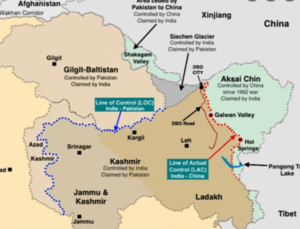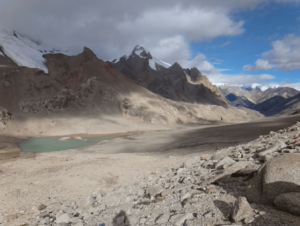New satellite images show China’s roadwork near Siachen Glacier
Satellite images have recently recorded China building a new road in the Pakistan-Occupied-Kashmir (PoK) Shaksgam valley, close to the Siachen glacier. The close proximity of the road to India’s forward-most border positions has been a worrisome development for current Indo-China relations.
The Shaksgam Valley was ceded to China by Pakistan in 1963 (Sino-Pakistan Frontier Agreement 1963) to settle their existing border disputes. According to recent satellite images, the newly built Chinese road is an extension of Highway G219 located in Xinjiang Province, China, and heads on into the mountains approximately 50 km north of India’s northern border point, Indira Col in Siachen Glacier.

According to reports from India Today, Indian Defence Minister Rajnath Singh has visited the border post twice since March. The satellite images captured by the European Space Agency record the construction of the road beginning in June–August of last year.
Indian military officials have stated that the newly built Chinese road passes through Aghil Pass, in Siachen. A territory that served as India’s interim border with Tibet before 1947. The close proximity of the road to Indian border posts in Siachen Glacier has sparked speculations about China’s hostile intentions.

Lt. Gen. Rakesh Sharma, former commander of the Indian Army’s Fire and Fury Corps that oversaw defence operations in Eastern Ladakh, Kargil, and Siachen Glacier, have stated the newly built Chinese road’s close proximity to Indian territory is a flagrant violation of the diplomatic ties between the nations. He also suggested that the Indian Defence Ministry should register a formal diplomatic protest with China.
A new road in China-occupied Kashmir sparks border disputes
The new Chinese road situated in Aghil Pass has long been claimed by India as part of the Trans-Karakoram Tract. As of 2024, the official maps of the Indian Union include the region as Indian territory.
The Shaksgam valley agreement between Pakistan and China back in 1963 allowed China to exert its military presence in the 5,300 sq. km. valley, despite India’s diplomatic protests.
The satellite activity was first noticed by a terrain enthusiast of the Indo-Tibetan region on X (formerly Twitter) named ‘Nature Desai”.
Time-lapse showing Chinese road approaching Aghil Pass. It all started last summer and the basic trail was completed in early autumn.
They have resumed further construction this month with construction approaching areas immediately north of India held Siachen Glacier.
3/4 pic.twitter.com/sr0EZl8MtA
— Nature Desai (@NatureDesai) April 21, 2024
The new road built under China’s Belts and Roads Initiative (BRI) at Aghil Pass signals stronger military cooperation between the countries while undermining India’s territorial sovereignty. Aghil Pass historically served as a frontier of the Indo-Tibetan region and was recognised by past rulers of China.
The considerable investments that China has made in developing strategic infrastructure projects threaten India’s existing security situation high up in the Himalayan Siachen Glacier.

Security experts like Lt. Gen. Sharma also alleged that the new road may be used to better facilitate the transport of radioactive minerals like uranium from Gilgit Baltistan back to Xinjiang. He also highlighted the possibility of troop and arms supplies being brought in closer to the border regions in case of faster deployment against India.
India protests via diplomatic channels against China
The Indian government has often reiterated India’s claim on the disputed regions and stated that, despite Shaksgam Valley being under China’s military presence, the official control of the region is under India.
Aghil Pass served as the northern frontier of Kashmir and Sinkiang in bygone times.
Here is the approach to Aghil Pass and recent imagery showing the Chinese road at the Aghil Pass.
The change in the status quo in Tans-Karakoram is almost impossible to reverse.
2/4 pic.twitter.com/ghO0CNhWIo
— Nature Desai (@NatureDesai) April 21, 2024
Indian Defence Minister Rajnath Singh has often said, “The lack of political legitimacy is being covered up by the rapid construction of strategic infrastructure on China’s side; the rapid growth of roads, border posts, and depots is a sure sign of China’s illegal claim to Indian territories.”.

Back in 2017, China had built another road close to Indian border points in the lower Shaksgam Valley, west of the famed Trans-Karakoram Pass. The new road has sparked speculation that violent clashes between Indian and Chinese troops may start again, as was the case back in 2020 during the Galwan Valley clashes.












Comments 2